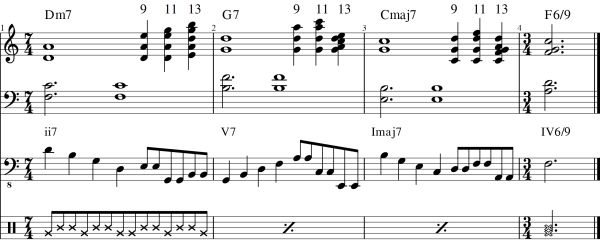Audio: extended chord (0:12)

extended chord plays extended chords by a trio comprising electric piano, bass and congas. The extended chord figure shows the score.
An extended chord is a tertian chord formed by extending a seventh chord.
There are three extended chords:
An extended chord is constructed by literally piling thirds one on top of the other until you run out of notes. Two consecutive thirds constitute a triad, three consecutive thirds a seventh chord, and four to six consecutive thirds make an extended chord. The thirteenth chord contains all seven notes in a scale. There is no fifteenth chord because there are no more notes left in a seven note scale to form such a chord.
An extended chord is an extension of a seventh chord. The quality of the intervals of third and seventh determine the quality of the extended chord and its notation. A ninth chord notated 9 is an extension of a dominant seventh chord, a maj9 is an extension of a major seventh chord, and a m9 is an extension of a minor seventh chord. The same notation applies to eleventh and thirteenth chords.
An extended chord is used to thicken the sound of a triad or a seventh chord.
An extended chord can be voiced in hundreds, even thousands, of ways. A complete Cmaj11 chord, for example, can be voiced complete as CEGBDF, or incomplete with five notes, CEBDF, by omitting the fifth, or incomplete with four notes, CEBF, the tonic, third, seventh plus the extension. It is not uncommon to voice an extended chord in this manner. Another way to voice is to place the two guide notes in the lowest register, as shown in extended chord. The guide notes, the third and the seventh above the root, identify the chord as a seventh chord or one of its extensions.
The 6/9 chord in the last bar of extended chord is an interesting chord with a nice smooth sound. It is constructed by adding a ninth to a major sixth chord. It includes an interval of a ninth but is not treated as an extended chord because the term, extension, is exclusively applied to the seventh chord not the sixth chord. Another interesting feature of the 6/9 chord is it contains all the notes in the major pentatonic scale.
An extended chord is a good illustration of the difference between theory and practice. Jazz practice embraces dissonance, but jazz theory is not entirely consistent on the matter. Some theorists suggest there are certain notes which should be excluded from a chord because they make the sound too dissonant. The note to be excluded is called an avoid note. It is a diatonic note, one that is part of the prevailing key. The avoid note in major harmony is the fourth degree of the scale. For example, the note F should not be added to a C7 chord (yet C11 contains the note F). The avoid note in minor harmony is the sixth degree of the scale. Avoiding dissonance is entirely reasonable in functional harmony, which has pretty clear views about consonance and dissonance, but seems out of place in jazz harmony. Having brought this anomaly to your attention, it will not be mentioned again.
The thirteenth chord can be constructed from secundal, tertian or quartal harmony. A C13 chord voiced CEGBDFA is a tertian chord spanning two octaves. C13 voiced CDEFGAB is a secundal chord spanning an octave. C13 voiced CFBEADG is a quartal chord spanning three octaves. The voicing is different in all three chords, the system for constructing the chords is different, yet there is only one C13 chord. It is a surprising fact, but there is only one diatonic chord with 7 notes. An even more surprising fact is that chords with four differing notes offer the greatest amount of freedom in music. There are fewer chords with 5 notes than 4, even fewer with 6 notes and only one with 7 notes.